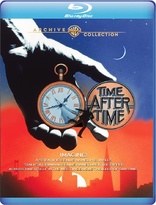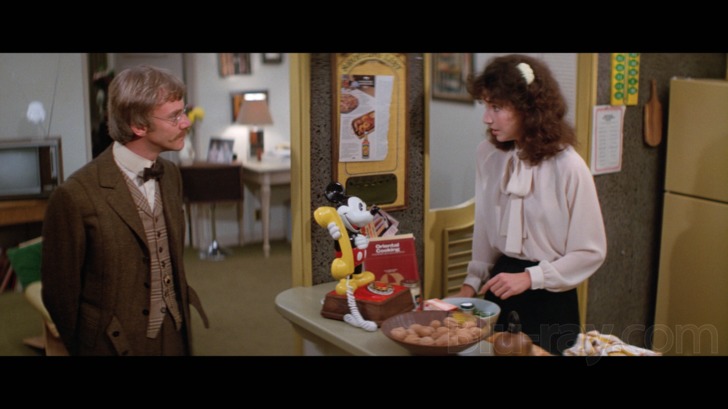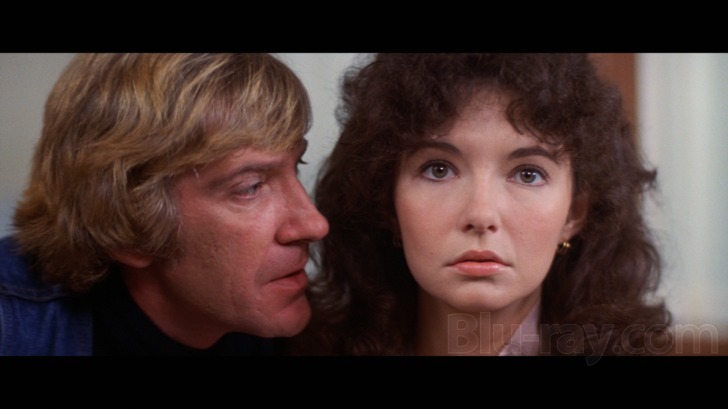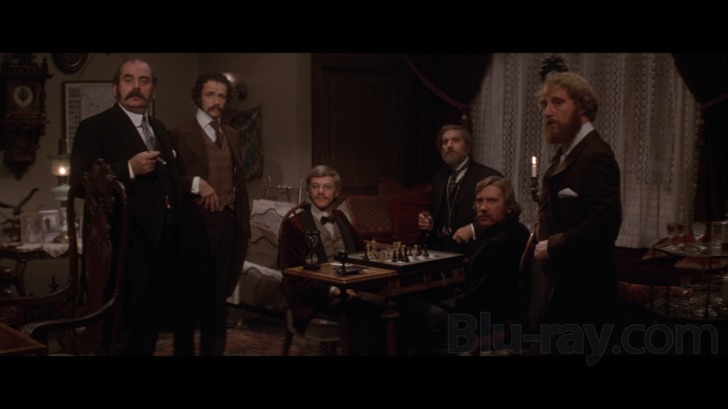Time After Time Blu-ray Movie
HomeTime After Time Blu-ray Movie 
Warner Archive CollectionWarner Bros. | 1979 | 112 min | Rated PG | Nov 15, 2016

Movie rating
7.4 | / 10 |
Blu-ray rating
| Users | 0.0 | |
| Reviewer | 4.0 | |
| Overall | 4.0 |
Overview
Time After Time (1979)
H.G. Wells pursues Jack the Ripper to 20th Century San Francisco when the notorious serial murderer uses the writer's time machine to escape the police.
Starring: Malcolm McDowell, David Warner, Mary Steenburgen, Charles Cioffi, Kent Williams (V)Director: Nicholas Meyer
| Thriller | Uncertain |
| Sci-Fi | Uncertain |
| Adventure | Uncertain |
| Romance | Uncertain |
Specifications
Video
Video codec: MPEG-4 AVC
Video resolution: 1080p
Aspect ratio: 2.40:1
Original aspect ratio: 2.39:1
Audio
English: DTS-HD Master Audio 2.0 (48kHz, 24-bit)
Subtitles
English SDH
Discs
Blu-ray Disc
Single disc (1 BD)
Playback
Region free
Review
Rating summary
| Movie | 4.0 | |
| Video | 4.5 | |
| Audio | 4.0 | |
| Extras | 2.5 | |
| Overall | 4.0 |
Time After Time Blu-ray Movie Review
Time's Arrow (and Cupid's)
Reviewed by Michael Reuben November 17, 2016Writer/director Nicholas Meyer will probably always be best known for his work on the Star
Trek franchise. He directed (and did uncredited rewrites on) Star Trek II: The Wrath of Khan; he
co-wrote Star Trek IV: The Voyage
Home; and he directed and co-wrote Star Trek VI: The
Undiscovered Country. Currently he is listed as a writer on the upcoming Trek TV series, Star Trek: Discovery.
But Meyer's first love is historical fiction, as shown in his novel and screenplay for The Seven-Per-Cent Solution (1976), widely regarded as the best Sherlock Holmes story not written by
Sir Arthur Conan Doyle. (Well, at least until the BBC's Sherlock.) A few years later, Meyer became intrigued with one of Conan Doyle's contemporaries, H.G. Wells, author of
The Invisible Man, The War of the Worlds and, most importantly from Meyer's perspective, The Time
Machine. Adapting a then-unpublished novel by his friend Karl Alexander, Meyer made his directorial
debut with a film based on a simple but inspired premise: What if Wells hadn't just written about
a time machine but had actually invented one?
Time After Time was a box office disappointment, because it was mis-marketed as a story about
the film's villain, Jack the Ripper, whom the studio determined to have better name recognition
than H.G. Wells. People recognized the Ripper's name all right—and they stayed away. But the
film's reputation has grown since its initial release, because it appeals on multiple levels. It's part
chase film, part detective story, part sci-fi and, like most time travel tales, a commentary on what
changes and what remains constant through the ages. The film is also a love story, and it was one
of those lucky occasions, like To Have and Have
Not, when the actors fell in love at the same time as their characters, lending the film's romance a unique authenticity. Stars Malcom
McDowell and Mary Steenburgen were married a year after shooting Time After Time, and while
the marriage may have ended in divorce, the camera had already captured a blush of first
romance that still enriches the film.

In 1893, Jack the Ripper suddenly resumes his killing spree, and he is quickly revealed to be an eminent surgeon, Dr. John Leslie Stevenson (David Warner, whom Meyer would later cast as the Klingon Chancellor in Star Trek VI). After killing a prostitute, Stevenson arrives late to a gathering at the home of his long-time friend and chess opponent, H.G. Wells (McDowell). Wells has assembled his friends to announce his invention of a time machine and to bid them farewell as he embarks on his temporal journeys. But first the inventor explains some of the intricacies of the machine's operation so that, when the police appear at Wells's door seeking the Ripper, Stevenson is able to use it to escape into the future. Thanks to a homing function that is crucial to the plot, the machine returns to the present, but without Stevenson. After gathering every valuable in the house for barter, Wells enters the machine to pursue his erstwhile friend through time.
Both Stevenson and Wells find themselves transported to November 5, 1979, where they are no longer in London but in San Francisco, because the time machine is currently on display in an exhibit devoted to Wells's life and work. (Watch for a kid played by Lost Boys' Corey Feldman, who is the first person to spot Wells after he materializes.) As the astonished Englishman wanders an alien landscape filled with wonders such as television, automobiles, women in scanty attire and McDonald's, he gradually comes to understand that the utopia he has been forecasting in his writings never happened. War persists, violence is celebrated, and the urban landscape provides an all-you-can-eat buffet for a serial predator. As Stevenson says when Wells finds him: "The world has caught up with me and surpassed me. Ninety years ago, I was a freak. Today I'm an amateur."
The insatiably curious Wells is fascinated by everyone he meets in the future, but one person he encounters is equally fascinated by him. Amy Robbins (Steenburgen) is an officer at the local branch of the Chartered Bank of London, who provides Wells with a valuable lead, having recently changed pounds to dollars for another Englishman looking just as much out of place. A distinctly modern woman, Amy is instantly attracted to the courtly, reserved Wells, with his antique clothes and charming accent. As Wells and Stevenson pursue and evade each other across this unfamiliar terrain, Wells finds himself becoming ever more deeply involved with a woman who is unlike any he has ever known. Steenburgen's Amy is a unique creation: at once ditsy and intelligent, trusting and suspicious, devoted to her career but all too willing to abandon her responsibilities when the right man appears. If Wells were merely traveling through time as he originally intended, Amy would be more than enough of an adventure for him—but he has a ruthless serial killer to catch.
By contemporary standards, Time After Time moves at a leisurely pace, but it never drags, because Meyer effectively juggles his multiple plots so that they reinforce and bounce off each other. He even sends the increasingly desperate time traveler into a police station to seek the aid of local authorities, where a skeptical cop (Charles Cioffi, Klute) manages to keep a straight face when this strange man with the fantastic story uses a familiar alias that he mistakenly assumes will have been long forgotten: Sherlock Holmes.
Time After Time Blu-ray Movie, Video Quality 

The cinematographer on Time After Time was Paul Lohmann, who had recently photographed
another film set in San Francisco, Mel Brooks's High
Anxiety. (He also shot Robert Altman's
Nashville.) The production used recently developed
anamorphic lenses from Panavision that allowed them to capture wide vistas on location in the Bay Area. Nineteenth Century London
was created on backlots and soundstages.
As with another recent Warner Archive release, The
Goodbye Girl, the only existing HD master of Time After Time had been prepared for TV broadcast years ago, without
adequate color-correction or cleanup. For this 1080p, AVC-encoded Blu-ray, Warner's Motion Picture Imaging
facility created a new scan at 2K from a recent IP, which was then assigned to one of MPI's
premiere colorists to achieve an accurate reproduction of the film's pictorial scrapbook of
Northern California in the late Seventies. Colors are somewhat understated: not exactly pale but
also not overly saturated; even the bright yellow and red plastics of Amy's Mickey Mouse
telephone don't "pop" as they might in contemporary film. The 1979 sequences are dominated by
the cooler hues of plastic and polyester, while the scenes in 1893 feature the warmer shadings of
wood paneling and woolen attire. Flesh tones appear accurate throughout. The brightest hues are
reserved for the time travel sequences, where the effects are obviously dated and analog, but that
quality lends them a certain charm (at least for my taste). Detail tends to fall off in these effects
scenes, due to the use of opticals, but it is otherwise as good as the film stocks of the era permit.
Detail is also reduced in nighttime scenes, but this is the product of lighting choices, and
visibility is never compromised. WAC has mastered Time After Time at its usual high bitrate of
just under 35 Mbps.
Time After Time Blu-ray Movie, Audio Quality 

Time After Time's stereo soundtrack has been taken from the original three-track magnetic master
and encoded in lossless DTS-HD MA 2.0. The film was an early Dolby Stereo release, and sound
designers were still exploring the potential of the new format. Although there is noticeable stereo
separation, especially in the lush orchestral score by Miklós Rózsa (Double Indemnity and Ben-Hur, among many others), much of the track remains anchored to the center, even in sequences
that cry out for distinct channels. An obvious example is Wells's journey into the future, which
is accompanied by audio clips from radio and TV marking major events in world history; the
sequence would be more effective if the historical voices alternated between left and right, but
they are effectively monoaural. The track has adequate though unremarkable dynamic range, but
this appears to be a limitation of the source. Dialogue is always clear. Having experimented with
playing the track in both a "pure" two-channel configuration and with matrix decoding, I
recommend the former, because the matrix decoder tended to collapse everything toward the
center.
Special mention should be made of Miklós Rózsa's score, which often seems to echo the style of
Bernard Herrmann—an appropriate element for a love story set in San Francisco. Nicholas
Meyer has said that he did not consciously attempt to reference Hitchcock's Vertigo, but the film contains a scene set among the redwoods of Muir Woods, where Scottie Ferguson and Madeleine
Elster embraced, and it's hard not to be reminded of those doomed lovers while watching Wells
and Amy in the same location to the strains of Rózsa's orchestra.
Time After Time Blu-ray Movie, Special Features and Extras 

The extras have been ported over from Warner's 2002 DVD release of Time After Time, with the
omission of trailers for The Time Machine (both the 1960 original and the 2002 remake). The
film's trailer has been remastered in 1080p, although there are limits to how good it can look,
given the rough shape of the source material.
- Commentary with Director Nicholas Meyer and Actor Malcolm McDowell: Recorded in 2002, the star and director were interviewed separately, but their comments have been cleverly edited to convey the impression that they are conversing. (The giveaway is that each refers to the other in the third person.) Meyer talks about being a first-time director and points out numerous elements that he would handle differently now. McDowell reminisces about shooting the film and working with his future (ex-)wife, who, according to McDowell, describes Time After Time as a photo album of their courtship.
- Trailer (1080p; 1.78:1; 2:33).
Time After Time Blu-ray Movie, Overall Score and Recommendation 

Time After Time is one of the films most requested from the Warner Archive Collection, and it
has already proven so popular that a second pressing was ordered even before street date. Fans
who have been patiently awaiting the film's Blu-ray release can be reassured that WAC hasn't let
them down. Highly recommended.
Similar titles
Similar titles you might also like

The Time Machine
1960

The Time Machine
2002

Brainstorm
1983

Master of the World
1961

Mysterious Island of Beautiful Women
1979

Detour
2016

Year of the Comet
1992

The Six Million Dollar Man: The Complete Series
Collector’s Edition | + Crossover Episodes & 6 films
1973-1994

65 4K
2023

Norman
2019

Gates of Heaven
1978

Jivaro 3D
Lost Treasure of the Amazon
1954

James Cameron's Story of Science Fiction
2018

Cinerama's Russian Adventure
1966

Mars
2016

Cinerama: Search for Paradise
1957

Cinerama: South Seas Adventure
1958

Trekkies
25th Anniversary Edition
1997

Windjammer: The Voyage of the Christian Radich
Deluxe Edition
1958

Star Trek: The Motion Picture 4K
The Director's Edition | Remastered
1979